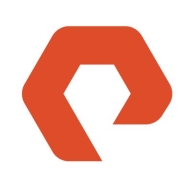


Red Hat Ceph Storage and Hitachi Content Platform compete in the object storage solutions category. Hitachi Content Platform appears to have the upper hand due to its advanced data management and governance features.
Features: Red Hat Ceph Storage offers scalable data storage, flexible integration across platforms, and support for diverse infrastructure. Hitachi Content Platform provides advanced data management, strong governance capabilities, and enhanced control and security over data.
Room for Improvement: Red Hat Ceph Storage could improve its advanced data governance features, interface usability, and initial setup process. Hitachi Content Platform may benefit from more competitive pricing, streamlined integration processes, and enhanced scalability options.
Ease of Deployment and Customer Service: Red Hat Ceph Storage provides a flexible deployment model with extensive support resources for smooth integration. Hitachi Content Platform offers a structured deployment process with strong customer service, appealing to businesses seeking reliable assistance.
Pricing and ROI: Red Hat Ceph Storage is praised for competitive initial costs and favorable ROI, making it attractive for budget-conscious buyers. Hitachi Content Platform may have higher upfront costs but delivers significant ROI through its advanced features and long-term benefits.
| Product | Market Share (%) |
|---|---|
| Red Hat Ceph Storage | 17.3% |
| Pure Storage FlashBlade | 5.7% |
| Hitachi Content Platform | 1.6% |
| Other | 75.4% |



| Company Size | Count |
|---|---|
| Small Business | 11 |
| Midsize Enterprise | 11 |
| Large Enterprise | 20 |
| Company Size | Count |
|---|---|
| Small Business | 4 |
| Midsize Enterprise | 6 |
| Large Enterprise | 4 |
| Company Size | Count |
|---|---|
| Small Business | 13 |
| Midsize Enterprise | 4 |
| Large Enterprise | 15 |
FlashBlade is the industry’s most advanced scale-out storage for unstructured data, powered by a modern, massively parallel architecture to consolidate complex data silos (like backup appliances and data lakes) and accelerate tomorrow’s discoveries and insights.
Hitachi Content Platform is an object storage solution that enables IT organizations and cloud service providers to store, share, sync, protect, preserve, analyze and retrieve file data from a single system. It is more efficient, easier to use, and capable of handling much more data than traditional file storage solutions. HCP automates day-to-day IT operations like data protection and readily evolves to changes in scale, scope, applications, storage, server and cloud technologies over the life of data. In IT environements where data grows quickly or must live for years, decades or even indefinitely, these capabilities are invaluable.
We monitor all File and Object Storage reviews to prevent fraudulent reviews and keep review quality high. We do not post reviews by company employees or direct competitors. We validate each review for authenticity via cross-reference with LinkedIn, and personal follow-up with the reviewer when necessary.